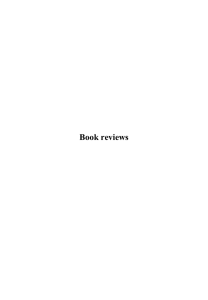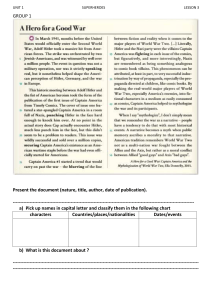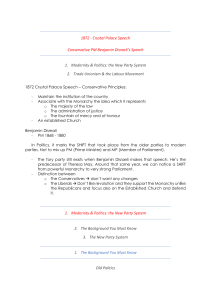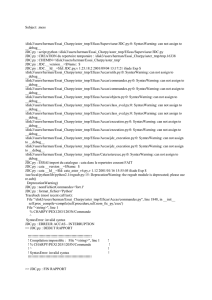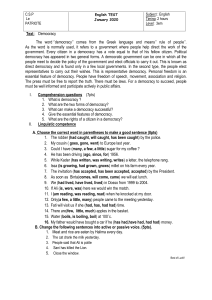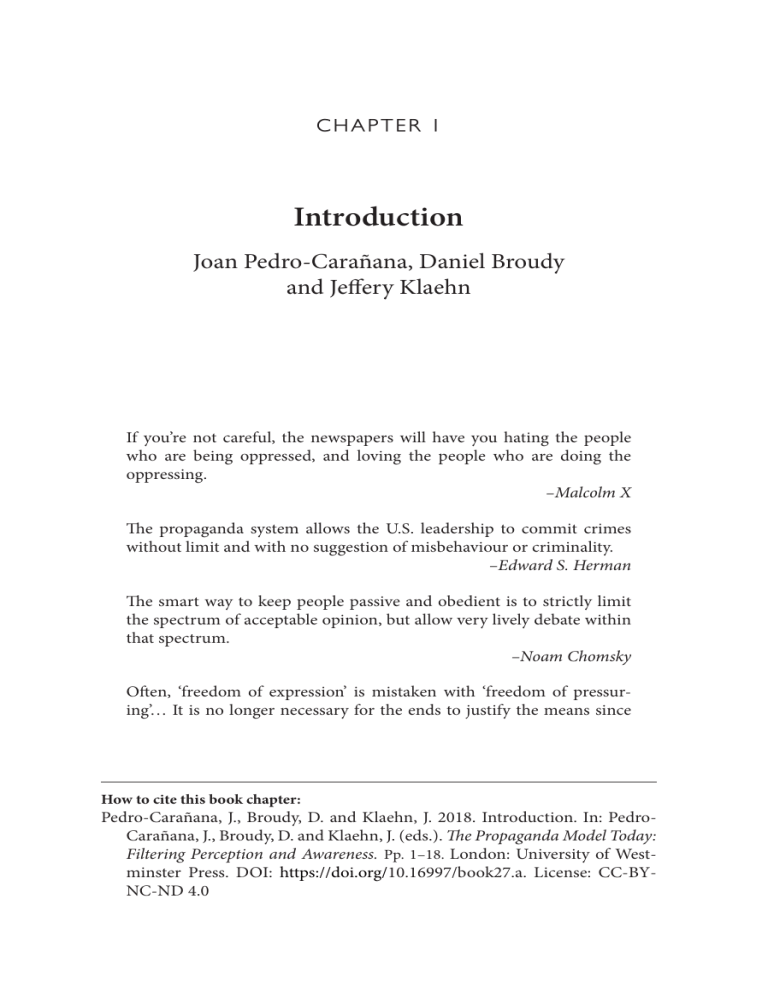
CH A PT ER 1 Introduction Joan Pedro-Carañana, Daniel Broudy and Jeffery Klaehn If you’re not careful, the newspapers will have you hating the people who are being oppressed, and loving the people who are doing the oppressing. –Malcolm X The propaganda system allows the U.S. leadership to commit crimes without limit and with no suggestion of misbehaviour or criminality. –Edward S. Herman The smart way to keep people passive and obedient is to strictly limit the spectrum of acceptable opinion, but allow very lively debate within that spectrum. –Noam Chomsky Often, ‘freedom of expression’ is mistaken with ‘freedom of pressuring’… It is no longer necessary for the ends to justify the means since How to cite this book chapter: Pedro-Carañana, J., Broudy, D. and Klaehn, J. 2018. Introduction. In: PedroCarañana, J., Broudy, D. and Klaehn, J. (eds.). The Propaganda Model Today: Filtering Perception and Awareness. Pp. 1–18. London: University of Westminster Press. DOI: https://doi.org/10.16997/book27.a. License: CC‐BY‐ NC‐ND 4.0 2 The Propaganda Model Today the means, the means of communication – the mass media – justify the ends of a power system that imposes its values on a global scale … [The] many are being held incommunicado by the few. –Eduardo Galeano 1. Reception of the Propaganda Model Edward Herman and Noam Chomsky first proposed their ‘propaganda model’ (PM hereafter) of media operations in Manufacturing Consent: The Political Economy of the Mass Media in 1988.1 Since then, the PM has seen noteworthy modifications2 and has attracted significant scholarly attention from around the world.3 While the individual elements of the propaganda system (or ‘filters’) identified by the PM (ownership, advertising, sources, flak and anti-communism) had previously been the focus of much scholarly attention, their systematisation in a model, empirical corroboration and historisation have made the PM a useful tool for media analysis across cultural and geographical boundaries. Despite the wealth of scholarly research Herman and Chomsky’s work has set into motion over the past decades, the PM has been subjected to marginalisation;4 poorly informed critiques;5 and misrepresentations.6 Interestingly, while the PM enables researchers to form discerning predictions as regards corporate media performance, Herman and Chomsky had further predicted that the PM itself would meet with such marginalisation and contempt. In current theoretical and empirical studies of mass media performance, uses of the PM continue, nonetheless, to yield important insights into the workings of political and economic power in society, due in large measure to the model’s considerable explanatory power. Its appeal also appears to come from the simplicity with which it may be used to investigate and elucidate how dominant institutional forces in society shape mass media performance. By illuminating ways in which power structures and privileged actors routinely impact patterns of media behaviour, the PM serves as a highly effective means of clarifying how dominant systems of propaganda and manipulation can affect capitalist societies, characterised by the increasing control of democratic institutions by financial and political-State forces to the detriment of the general population. In academic contexts currently marked by the de-politicisation of Cultural and Media/Communication Studies,7 this collection aims to introduce readers to the PM, to present cutting-edge research demonstrating the model’s general validity and to critically update, expand, and refine it.8 To these ends, we have brought together international researchers to analyse the continuities and new developments in media environments throughout various regions of the world. This volume, thus, endeavours to serve as a benchmark text for anyone interested in the PM, including students, scholars and researchers, con- Introduction 3 cerned citizens, social, political and media activists as well as policy­makers across a range of disciplines, such as communication/media studies, sociology, political science/international relations, peace/war studies and political economy. While this collection is aimed primarily at a particular audience, it is also constructed in a way that remains widely accessible to a more general readership concerned about the influence of propaganda on the public mind and the mechanisms through which the power elites exert control over society through media. The volume locates these latest studies on media systems within the wider body of work already built on the PM so as to contextualise, refine, clarify and improve the model’s utility and validity. By bringing together a number of leading scholars on the PM at an international level, we strive to give greater shape to a school of thought rooted in Herman and Chomsky’s original work, which has seen various developments throughout the years via theoretical reflection and application to specific case studies. An example of the development of PM scholarship, and predecessor of this volume, is the work undertaken by Klaehn, which focused on the model’s theoretical, methodological, applied, and practical dimensions.9 2. The Propaganda Model and the Political Economy of Media The political economy approach and institutional analysis of the mass media that the PM follows is embedded in the tradition of radical mass media criticism.10 The PM connects directly with the US tradition of critical, empirical studies11 and draws upon previous research on the historical evolution of the media, including in the UK.12 The PM shares with Marxian analysis the materialist criticism of domination and of the power structures that affect the media, as well as a historical perspective. However, Herman and Chomsky did not specifically position the PM within the Marxian scholarship of media and communication. The original conceptualisation of the model differs from Marxian analyses that specifically focus on contradictions affecting the media and the possibilities of journalism to contribute to social justice.13 Instead, the book Manufacturing Consent emphasised the key dimensions of elite power that restrict media performance and drastically reduce the possibilities of promoting egalitarian change. However, the PM is also attentive to divisions among the elites and the emergence of strong social movements to explain the opening of the range of opinion in the media. Moreover, this volume shows that PM scholarship is also analysing the role played by journalists and professionalism, the changes that digital technologies are prompting, national contexts, and the influence of audiences and media activism on news production. The PM perspective coincides with Marxian analysis of the media as part of a wider capitalist system oriented toward profit maximisation and the inces- 4 The Propaganda Model Today sant accumulation of capital in increasingly oligopolistic contexts. The PM understands media structures and contents, thus, to be shaped by corporateState powers and oriented toward the production of profits and the reproduction of class societies. Therefore, the PM would not apply to nations, societies, and communities where alternative forms of organisation and values appear. In so-called ‘communist’ states of the present (and past) while capital doesn’t (and didn’t) rise above the authority and power of the decision-making central authority, obvious social and economic inequities and inequalities appeared, and these gaps necessitated the use of various forms of consent and compliance with the system. However, these propaganda systems differ from Western systems of propaganda because the dictatorial State plays the central role in determining media contents, there is prior censorship and physical repression of dissidents, and the media opinion is much more monolithic. The PM clearly does not apply to societies where the manufacture of consent isn’t necessary for the maintenance of a capitalist order that generates and maintains inequality, inequity, and oppression. The earliest kibbutz of Israel, for example, approximated most closely societies in which the manufacture of consent was subsumed by the high value its members placed upon common goals. Today, peace journalism and communication for conflict resolution provide a different perspective for journalistic practice. Alternative media outlets based on workers’ cooperatives and reader-supported news provide information which differs significantly from mainstream contents. For example, Amy Goodman of Democracy Now! was the only journalist who covered the first protests of indigenous people against the construction of the pipeline in their lands in North Dakota. She was disciplined through serious flak as she faced riot charges that were, ultimately, rejected by the judge. Alternative forms of communication are also being practiced by indigenous peoples throughout Latin America through community media that promote values of living in common, social justice, mutual understanding and harmony with nature. For example, communication based on the cosmovision and practice of Sumak Kawsay (Good Living) appeals to harmony between individuals, individuals with society, and both with nature as part of the same totality. 3. The (Ideal) Democratic and Egalitarian Role of the Media At a time when grassroots movements and emerging political forces are aiming to intervene in the privatized media sphere and eventually transform it, a necessary step before any meaningful change can be achieved is a better understanding of the functioning and functions of media, i.e. how and why mass media contribute to the (re)production of the existing order with its unjust class structure, its increasing inequalities and inequities, the manifest reality of perpetual war, the structural limitations to rights and freedoms, and the accelerated erosion of democratic institutions that societies are witnessing across the globe. Introduction 5 As so many of the perceptions that people gather of events unfolding from place to place around the world are developed through vicarious experiences manufactured by media systems, their centrality to the configuration of our minds and worldviews cannot be understated. This mediating function permits populations to be in touch with real and fictional universes of reference and to (re)orient their attitudes and behaviours according to symbolic imaginaries and images that serve to mould their cognitive and emotional frameworks. While the PM does not offer a specific method of measuring precisely the quantitative emotional impact media have on the public mind, one underlying assumption is that, even as resistance to media influence is quite common, the systems of propaganda in place have historically tended to play a significant role in achieving in the public both conformity and consensus across sites of social conflict. Accordingly, mass media have traditionally been expected to perform a fundamental democratic function in the control of powerful institutions and in the development of a rational, deliberative and pluralistic public sphere14—and certainly more so in today’s hyper-mediated societies. In an ideal society, media would, by performing their fourth and fifth-estate function, act as instruments used for citizen empowerment and as the primary citizen watchdog over the ruling powers. Instead of deploying power over citizens to cultivate their views on issues central to their individual and collective lives, traditions born of the Enlightenment and of the working-class struggle have called for media systems that foster citizens’ capacity to engage in critical thinking and contribute consciously to their own social awareness and emancipation. Media systems freed from external pressures and constraints would, thus, feed the very freedom of thought necessary for the democratic functioning of societies. Historically, democratic media have been developed and continue to be employed as useful tools for resistance and social change, especially through the so-called ‘new’ or alternative media, though they appear mostly ineffective in counteracting the current hegemony held by the mainstream media. A political economy approach suggests that it is not possible to develop a genuine public sphere in conditions established by already existing capitalist influence. Therefore, the possibility of creating democratic and egalitarian media systems lies to a great extent in sweeping transformations that circumvent the influence of the filters identified by the PM, as well as the dismantling of other oppressive social and political structures. 4. Propaganda and Power Next to the ideal conception of media performance, the opposite perspective has been defended and put into practice by state and corporate elites. Already Aristotle developed a systematic analysis of rhetoric as the art of persuasion, arguing that rhetoric had often been used to manipulate emotions, hide crucial facts, and seek to convince the other party of ideas and concepts contrary to their own interests, but which could also be developed into modes 6 The Propaganda Model Today of ­persuasion based upon philosophical knowledge for enlightenment and the common good.15 In the early sixteenth century, Niccolò Machiavelli understood (and practiced) clearly how power operates as a social relation and depends, to an important extent, on the development of ideological instruments for the control of one group over another.16 One of the first intellectuals to develop an in-depth analysis of the role of communication, sociology and ‘publicity’ in (emerging) industrial societies was Auguste Comte.17 The French sociologist broke with humanist-Enlightenment social knowledge that conceived progress as human development and happiness as self-realisation to identify them with industrial productivity and security based upon obedience. In the Comtian dystopia, the ‘spiritual power’ (the media, education, publicists, social science) of the ruling elites would become fundamental so that the societal, ‘changes that are inevitable [would] seem desirable to those who will [invariably] suffer the misery, fatigue, illness, and unhappiness that are the unavoidable costs of progress.’18 Comte’s positivist sociology, or ‘social physics’, sought to abandon the idea of developing knowledge based on ethical principles in favour of allegedly value-free knowledge that would be better suited to defining and organising the nascent industrial society. An exact knowledge of society would allow objective social action, i.e. action adapted to the needs of the economic system for techno-industrial development, irrespective of human values or its convenience for the majority of the population. For Comte, the public mind needed to be readapted to the developing demands of industrial capitalism in a manner that would make the people’s brain a mirror image of the external order. Thus, there would no longer be sufficient time or space for men and women to contemplate the possibilities of social change based upon shared human values, but merely the manufactured need for them to attend, against their own interests, to the new capitalist system, its perpetual maintenance, and the new alliance of the industrial bourgeoisie with the Restored monarchies. In the same vein, the transition to an industrial system that generated great suffering in the US was guided long ago by a State-Corporate nexus promoted by those who Jefferson labelled the Aristocrats, i.e. the elite sectors of society that distrust and fear the common people (pejoratively referred to as the ‘rabble’ or the ‘mob’) and aim to constrain its power and transfer it to the dominant classes.19 Needless to say that they succeeded in imposing their designs on the Democrats, who had viewed the people as the safest depository of the public interest and the legitimate safeguard of democracy against corruption and abuses of power by government and corporate institutions.20 Propaganda and miseducation would serve as the principal tools in re-engineering the desires and tastes of a largely rural, self-organised and cooperative population and presenting to it a specific form of industrialisation centred around a system of wage-labour promoted by the aristocratic State, bankers, and other corporate leaders. In the early twentieth century, the Italian militant communist Antonio Gramsci contended that any social order and dominant historical bloc relies not only Introduction 7 on violence and coercion, but also on the production of cultural hegemony, which leads to the attachment of the subordinate classes to the worldview and interests of the dominant classes.21 A very similar line of thought was developed by several founders of media and Communication Studies in the United States, such as Edward Bernays, George Creel, Walter Lippmann, Paul Lazarsfeld and Harold Lasswell: a sophisticated system of propaganda was needed to persuade the masses to comply with the interests of the dominant classes.22 In turn, their theories provided the intellectual and historical foundation upon which Herman and Chomsky constructed the propaganda model. As is well known, the title of the book in which the authors originally propound the propaganda model, Manufacturing Consent, references a passage in Lippmann’s c­ lassic work on public opinion and propaganda. From a positivist-behaviouristfunctionalist perspective, these founding figures offered elaborated theories for alternative terms of the ‘engineering of consent’, ‘crystallisation of public opinion’, ‘management of the public mind’, or ‘public relations’. In their view, regarding the governance of society, since there remain many fundamental issues evidently too important and complicated to be left in the hands of what they saw as the ignorant masses, the ruling classes would need effective ideological and axiological tools to maintain their dominance in an increasingly complex world that might otherwise see the widespread emergence of movements toward genuine social justice. Elemental to these conceptual tools were Sigmund Freud’s theories of psychoanalysis, which would serve to hasten public consent to new behaviours (e.g. consumerism and indebtedness), to the establishment of repressive policies (e.g. curbing workers’ rights) and to decisions the population did not originally desire (e.g. war). According to Chomsky, the underlying position of the social engineering perspectives is synthesised in the idea that ‘propaganda is to a democracy what the bludgeon is to a totalitarian state,’23 i.e. with the transition from absolutist and dictatorial systems to formally democratic and mass-consumerist societies, the use of violence for the control of the population ceases to be legitimate and thus ideological means of domination must be devised and deployed. The great victory for the masses that saw the establishment of democracy could, in effect, be counteracted by enlarging the distance between the people and their elected representatives through media manipulation. As Machiavelli had already shown, the institutions in charge of exercising power are not usually the great safeguard of the general interests as it is widely claimed, but they, instead, function in favour of special interests.24 That is, representative institutions today operate to satisfy the interests of the political and state elites, which, in turn, work in symbiosis with the financial and economic elites, who exercise tighter controls over the economy and government policy-making. In Lippmann’s words, a ‘spectator democracy,’25 instead of a democracy of informed and engaged participants, has widely developed through the production of redundant misinformation, the development of a culture of fear (‘Danger! 8 The Propaganda Model Today Danger!, shouts the dangerous’, as Galeano ironised) and an overabundance of trivial entertainment framed within elite perspectives—all of which work in concert to frustrate the efforts of the general public to make full sense of the wider world of which they are members, the position they occupy, and the real possibilities available to those who seek to organise for social change. With the hijacking of democracy by state and financial powers that started in the 1970s-80s, there is an ongoing trend of upward transference of wealth, intensification of inequality, and reduction of social and human rights. This trend is also clearly reflected in the increasing concentration of mass media ownership, which has come with the demise of an historically egalitarian distribution of media power which any democracy naturally requires for its proper functioning. We can observe the results at present in the appearance of an ever-widening chasm between the majority of the population and the political and economic elites. These gaps have certainly not gone unnoticed. Alongside the movements of resistance that develop against this kind of domination exerted by the ruling classes there have also been significant responses brought to that resistance by the elites. A paradigmatic example of such a response can be found in the strategic development of an international organisation of neoliberal elites. Founded by David Rockefeller and Zbigniew Brzezinski, the Trilateral Commission produced its first significant analysis of the ‘democratic surge’ of the 1960s, which provoked, ‘a reassertion of the primacy of equality as a goal in social, economic, and political life’ and ‘a general challenge to existing systems of authority, public and private,’ including, hierarchy and wealth. The commission’s inaugural analysis outlined in The Crisis of Democracy 26 casts the problem as an ‘excess of democracy,’ which prescribes ‘a greater degree of moderation in democracy’ both at the social and media levels.27 This moderation would entail the reaffirmation of anti-democratic principles and the marginalisation of the ideas propagated during the 1960s, which ‘only frustrate the purposes of those institutions.’28 In synthesis, the solution would be to establish ‘desirable limits to the indefinite extension of political democracy.’29 The political and economic powers should, thus, employ their influence to control the type of communication and education provided to citizens so as to reduce their capacity to engage in egalitarian and democratic social change. According to the propaganda perspective, the threat for the power elites posed by an educated and informed populace can be counteracted without overt coercion that would seem unacceptable in a democracy. This is the reason that media work to manage the fiction of promoting plural debates and even of being critical of established powers. But this strategy allows only for lively debate within very narrow boundaries that do not question the overall oppressive structure of contemporary societies and marginalise critical-emancipatory views. And, very often, debates only reflect the tactical divisions among the different sectors of the elite that want their views to be heard and disseminated (e.g. Watergate).30 Moreover, spaces for more freedom of thought and critical Introduction 9 comment can occasionally be found—even as they tend to be closed in a short period of time—when the media face important contradictions, including widespread citizen mobilisation opposing certain government activities (like launching a preventive war against a defenceless nation) and pressuring for more reliable information.31 5. Social and Media Structures and Contents The most effective way to control the media is, thus, not through direct control in fascist or Soviet-style, totalitarian systems. Instead, the media are subject to less visible, market and political mechanisms that tend to filter the information that is fit to print in a non-conspiratorial way—even as agency of concrete people is fundamental. This book explains the mechanisms through which structures of wealth and corporate-State power filter media production, exclude many critical journalists, and limit the democratic possibilities of mediated communication. Moreover, it identifies the relations between the structural conditions within which the media operate and the contents they elaborate for both elite and mass consumption. The systematic analysis proposed by the PM, thus, enables us to assay media systems at two interrelated levels. At one level, the filters allow for identifying the economic, political and ideological conditions of media production in milieus marked by a powerful alliance between capital and political-State forces. These filters and relations explain why the media perform a propagandistic role oriented toward the reproduction of the existing capitalist, warmongering socio-political order as well as the tactical changes in the system that are required for its further continuity and expansion. At the same time, the PM allows for the rigorous study of how the mainstream media undertake this role through content and discourse analysis of the products they deliver to the audience. We employ this comprehensive approach to systematically expose and explain the central role played by the media in contemporary societies marked by increasing instability, chaos and inequality promoted by the dominant powers at both national and global levels. The collection is, therefore, theoretically informed and empirically grounded. Moreover, while this volume considers new developments in media environments marked by rapid shifts in technology, it also analyses contemporary case studies of international relevance in a period of worldwide, structural dominance of global media moguls.32 We begin with the recognition that the advent of the internet—as has occurred during preceding technological ­revolutions— has been underpinned by techno-centric, techno-utopian, and technocratic discourses that marginalise human values and social relations in their analysis of the significance of new media, propagating the fiction that technological advancements in and of themselves engender social and economic utopias.33 10 The Propaganda Model Today Accordingly, the emergence of the internet would naturally lead to an historical period marked by human connectivity, intercultural understanding, democratization, equality, peace, and economic development. However, an historical perspective allows for observing the evolution of the internet from its origins as a collaborative tool for the free exchange of information and ideas within an increasingly commodified space now dominated by corporations in search of profit that together with State forces have established a system of massive surveillance, violation of intimacy, and elite influence. The humanist utopia of fostering cooperation and mutual understanding in platforms free from commercial and State control is, thus, giving way to the development of what increasingly appears to be a dystopia in which members of the global village are unified by the centralising forces of the market in close alliance with the State. The internet is, thus, being shaped by the intentional actions of elite actors as online citizen social interactions are managed by the algorithms of digital communications that are far from neutral.34 A critical, political economy approach to the study of new media is, therefore, required for concerned citizens to understand how the internet is shaped by much larger structures that limit their possibilities to engage in positive socio-political change and contribute to the accumulation of capital and the achievement of self-interested political goals.35 At the same time, explorations of the transformative potential inherent in digital media and their uses by citizens in popular movements have become necessary. Such analysis must acknowledge that after decades of propaganda conditioning and the increase of oppressive material realities and living conditions, the majority of social uses made of the internet are oriented toward the continued maintenance of prevailing inequities in power relations between different actors. As Morozov has exposed, one can readily observe important incongruities between the expected uses of new communication technologies as posited by commercial, State and pseudo-intellectual agents and their actual uses.36 In this vein, McChesney has noted a contradiction that can be located in the proliferation of techno-communicative capacities for social change and a widely de-politicised and de-mobilised citizenry, whose frustration and anger with the existing social order and their deteriorated living conditions are increasingly susceptible to exploitation by populist neo-authoritarian forces.37 However, the emergence of new social and political movements has also demonstrated an important capacity to influence the digital media sphere by combining grassroots organisation efforts and social mobilisation in the public squares and the streets with creative and innovative, communicative production in online social networks—even if notable influence has been temporary and susceptible to being assimilated by the system. Even though elite actors currently maintain hegemony on the internet, digital media can be understood as sites of ongoing struggle and contradiction within the framework of the power relations that affect digital media in processes marked by both control Introduction 11 and resistance. It is in this sustained tension between forces and counter-forces at both the social and communicative levels that new digital media can be explored as ‘spaces of hope’38—digital spaces that ought to work in complementary ways with social action on the ground if real and meaningful change is to be achieved. We employ the PM not only in the context of the rise of digital media, but within the development of new threats to democracy, to the general public, and even to the human species posed by global war, nuclear weapons, climate change, mass surveillance, the advent of populist neo-authoritarian forces, and other related challenges. Accordingly, we also focus on the media’s portrayal of emerging social and political movements developing and aiming to counteract the impositions posed by global capitalism, neoliberalism, and so-called policies of austerity. The collection we have assembled explores how the PM can be applied to analysis not only of contemporary media markets within the United States, but also more importantly beyond the market and media outlets initially examined by Herman and Chomsky. Uniquely, the book features an important underlying aim, which is to understand the PM’s generalisability across varied media systems and products, cultures and national boundaries, including the UK, Germany, Canada, Spain, and Latin America, analysing media performance within their respective context and assessing the utility of the PM to explain observed phenomena peculiar to specific media systems. 6. Functions of ‘Liberal’ Media While Manufacturing Consent was famous after its appearance for featuring Herman and Chomsky’s critical analysis of the New York Times’ coverage of certain key historical events, Todd Gitlin suggests in a recent Times obituary (November 21, 2017), where he had been interviewed by a Times journalist, that the PM emerges from a Manichean view of the world.39 In another obituary (November 16, 2017) to Herman, Gitlin observes that, ‘the whole approach to [Manufacturing Consent] is deeply simplistic,’—as if to intimate that the elegant simplicity of a model disqualifies it from serious consideration.40 Crucially, Gitlin’s claim is noteworthy for its misinterpretation—‘if you think that the New York Times is Pravda, which is … what [Herman and Chomsky are] saying’—as well as its over-simplification—‘then what vocabulary do you have left for Fox News?’ What the PM encourages and allows anyone to do is to investigate these important differences between so-called ‘liberal’ newspapers such as The New York Times and (ultra-) ‘conservative’ outlets such as Fox News. Contrary to Gitlin’s claim, the PM holds that even as media systems are oriented toward the reproduction of capitalist societies, they do not function in a homogeneous or monolithic way. 12 The Propaganda Model Today For PM scholars engaged in describing and analysing this system, however, one central function observed of the liberal corporate media is the necessity of acceptable limitation placed upon left-leaning opinion, especially in terms of the dimensions and depth of social transformation. While feigning favour for social equality, the so-called ‘liberal media’ evade and ignore the need for fundamental transformations in the economic system. (Ultra)conservative commentators at work in corporate news manufacturing entities respond by reproducing audacious (and ironic) claims when they criticise mainstream media as being liberal—i.e. too socially progressive. What continued to fascinate Edward Herman was, ‘how the conservative critics of the media who allege that the media are liberal have a tendency to ignore ownership. They sort of pretend that the media are controlled by Dan Rather and Peter Jennings and these people down at the bottom of the power hierarchy in the media.’41 Relations of ownership continue to be fundamental both in the media and in the broader social system, but they are hardly questioned in the media—whether conservative or liberal. The liberal media are also attentive to issues of gender and racial equality, but inattentive to representing the interests of the working class.42 They embrace sexual diversity but promote its commodification and categorical separation from class equality, which is required for the real materialisation of sexual diversity. In the words of Nancy Fraser, liberal media have adopted the position of ‘progressive neoliberalism.’43 Blithely coexisting in this oxymoronic milieu has been possible in the USA, Frazer notes, because of the late alliance of multiculturalist and pro-diversity social justice movements with the corporate forces of cognitive capitalism (Wall Street, Silicon Valley, Hollywood, the liberal media…)—an alliance which has been mediated by, reproduced, and materialised in the drone-­warfare figures of the Clintons and the Obamas. The limitations of such approaches are represented in media support for corporatised versions of ­feminism. Instead of working to disassemble dominant patriarchal social relations and the inequitable distribution of power, corporate feminism favours women’s struggles for power while ignoring the long-existing hierarchical ­corporate and political structures. Progressive neoliberalism uses diversity, with its positive connotations, as a strategic marketing tool for creating vacuous images of the corporate cool— the icons of a new ‘cosmopolitan’ age in which broader societal economic inequality and cultural imperialism continue to rise. While such a self-image of diversity is used as a self-legitimising strategy in terms of its public face and internal rationalisations, the liberal media watchdogs have left militarism and imperial expansion unchecked while uncritically supporting so-called ‘free trade agreements’ that grant even more power to economic globalist elites. Furthermore, as socalled liberal media have abandoned peace journalism, they have failed to examine the structural and cultural causes of violence as well as contemplate and offer possible solutions for peace-building and conflict resolution across cultures.44 Introduction 13 Liberal media establish the limits of economic discourse by featuring and promoting neo-Keynesian economists such as Krugman and Stiglitz while paying scant attention to the importance of workers’ cooperatives and Marxist economics. There is surely a significant difference between the systematic denial of climate change in ultra-conservative media on one hand and reports of liberal media based on empirical facts and alarming images on the other. But the problem with liberal media is that climate change is scarcely ever connected to capitalism, consumerism, extractivism, or their externalities, so these media ignore or fail to explore possible post-capitalist alternatives. Liberal media, colonised by neoliberal ideology, act as a governor that wields tight control over the definitions of key terms and concepts and, thus, prevents the public from imagining alternative social or economic realities.45 Crucially, liberal media ignore important analysis of the oligarchic superstructure of the media system itself and the negative consequences on journalism that critical scholars have already identified.46 Media owners and advertisers are content to commodify social movements and diversity only insofar as their packaging produces real profits. A range of ideologically acceptable sources is presented to signify plurality and diversity of opinion—so long as they maintain a refusal to question the corporate system itself. Sources and journalists who work outside of the boundaries of this framework are framed as radicals. The ideology of corporate diversity disregards the intersections of class with gender, race and sexuality and leaves little room for critiques of freemarket capitalism and for socialism. The possibility of nationalising, for example, key sectors of the economy is hardly considered. Having fully embraced the neoliberal agenda and its attendant austerity policies, the liberal media display little regard for ‘the losers of globalisation’, namely, the industrial working class or the exploited workers clinging to a life of slave wages. Instead of analysing in-depth why Trump’s fake populist appeals to the working class have been successful and what key roles these appeals have played, the liberal media have turned to ridicule and parody rather than to offer anything of substance to voters seeking potentially viable alternatives. Moreover, perhaps because of the conspicuous absence of a thoughtful alternative narrative, liberal media enable Trump to set the agenda in the public discourse while diverting Main Street attention away from the long-overdue need to enact reforms in the pro-Wall Street political landscape. Liberal media outlets include alternative reporting by critical journalists and intellectuals which are demanded by critical news consumers. Even as their reports play a fundamentally important role in keeping concerned citizens informed, such journalists represent a minority in newsrooms. Their appearance and effort might influence the development of their public star power (celebrity), but their minority position indicates that they are meaningless tokens used with pre-determined futility to challenge the general pro-­corporate approach to reporting in liberal media. Engaging in the charade, liberal media 14 The Propaganda Model Today conjure up the necessary illusions of plurality while neglecting potential transformations of the overall corporate structure that establishes the editorial line with its important influence on key decisions. Even as it is always better to feature more diversity, to adopt Marcuse’s term, the media use diversity as a form of ‘repressive tolerance:’[8] a few drops of alternative views easily diluted by the structural conditions of a vast mass media ocean. In sum, liberal media function under the conscious or unconscious sway of progressive neoliberal ideology, which serves as a form of self-legitimisation and self-gratification. Perhaps the greatest achievement realised in contemporary liberal media has been the re-engineering of liberalism itself, its positive connotations, and the narrowing, even further, of the range of thinking, speaking, and writing in progressive ways that challenge the hegemonic order. Seeing these alterations will provide readers of this volume insights into the rebranding of the left and how this insidious process has led substantially to the crisis of progressive politics and what this means for the working classes, the marginalised and the dispossessed. 7. Organisation of the Book This volume features four major divisions. Part I addresses the theoretical and methodological dimensions of the Propaganda Model. It begins with an interview with Edward Herman on the model itself, its place within academia, its usefulness to analysts and practitioners across disciplines, and its applicability to understanding both traditional and digital modes of media performance and output. Authors in this section of the volume discuss the functional utility as well as the ongoing marginalisation of the Propaganda Model within academic journalism studies, its consequences to professional practices, and the rationalisations that journalists make in reporting. Authors explore questions of how journalists are socialised within institutional cultures, how Journalism Studies have systematically avoided subjecting journalistic practices to analysis that could expose structural power inequalities. The section extends methodological considerations of the Propaganda Model from corporate media performance to the actual propaganda apparatus that shape the information environment. Part II reflects on propaganda as a concept and practice within new mediated digital communications systems and interfaces. Authors apply the elements of the Propaganda Model to corporate media as components of a larger System of social and ideological influence and coercion. They examine the characteristics and possibilities of digital activism in connection to physical activism for challenging the prevailing political order, as well as the responses they have received. Power relations, popular resistance, and concepts of democracy are carefully examined in the behaviour and language used by elites to guard the System against attacks. Introduction 15 Part III features applications of the Propaganda Model to forms of media and content not previously analysed within this theoretical framework. It presents analysis and arguments for expanding the scope of the model to include the entertainment industry through the analysis of television, professional sports, Hollywood movies and videogames. Quantitative and qualitative research methods are also presented for analysis of empirical evidence of political content in entertainment products. Authors argue that the PM with a broadened analytical range of media remains to be a strong conceptual tool for explaining and predicting media performance. Finally, Part IV presents case studies of corporate media and reporting practices as reflections of elite power. Authors investigate the institutional structuring of the media environment, its ideological influences and market constraints, its pro-capitalism and pro-militarism bent, and its performance in moulding, predicting, and controlling the behaviour of the masses. Authors examine how the Propaganda Model helps unfold the contradictions of policies and practices seen in massive public expenditures during periods of forced economic austerity, in imperialist activities cast as humanitarian and human rights interventions, and in the limitations placed on the public debate surrounding nuclear deterrence. In the concluding section, the editors pull together the plurality of theoretical and empirical studies presented in the collection to measure the validity of the three main hypotheses of the PM. We identify the fundamental dimensions of the PM, the key modifications and expansions that are suggested—such as the inclusion of new filters—and the model’s value for conducting research in different geographical contexts and media systems and products. In this conclusion, as in the rest of the book, we seek to contribute to elucidating the functioning and functions of the media in contemporary societies hoping that systematic knowledge about media structures and contents will further promote reflection among media practitioners, students and scholars as well as within broader sectors society. If our analysis is correct and the media engage in the production of diverse forms of symbolic violence, it becomes apparent that broad movements for the deep transformation of the media systems are required—movements which to be successful, of course, require wider transformations in the social and political order, especially regarding its class structure. Notes and Bibliography Edward S. Herman and Noam Chomsky, Manufacturing Consent: The Political Economy of the Mass Media. New York: Pantheon, 1988, 2002. 2 Herman and Chomsky, Manufacturing Consent; Edward S. Herman, ‘The Propaganda Model: A Retrospective,’ Journalism Studies 1, no. 1 (2000): 101–112. 1 16 The Propaganda Model Today Joan Pedro, ‘The Propaganda Model in the Early 21st Century – Part 1,’ International Journal of Communication 5, (2011a): 1865–1905; Joan Pedro, ‘The Propaganda Model in the Early 21st Century – Part 2,’ International Journal of Communication 5, (2011b): 1906–1926; Jeffery Klaehn, ‘A Critical Review and Assessment of Herman and Chomsky’s Propaganda Model,’ European Journal of Communication 17, no. 2 (2002): 147–182; Klaehn, Jeffery (ed.). Filtering the News: Essays on Herman and Chomsky’s Propaganda Model. Montreal: Black Rose, 2005; Klaehn, Jeffery (ed.). The Political Economy of Media and Power. New York: Peter Lang, 2010; Kiyomi MaedomariTokuyama, ‘Complicit Amnesia or Willful Blindness? Untold Stories in US and Japanese Media,’ in Under Occupation: Resistance and Struggle in a Militarised Asia-Pacific. (Eds. Broudy, D., Simpson, P., & Arakaki, M.). Newcastle upon Tyne: Cambridge Scholars Publishing, 2013: 98–125; Tabe Bergman. The Dutch Media Monopoly, Amsterdam: VU University Press, 2014; SourceWatch, ‘Propaganda Model,’ 2011. 4 Andrew Mullen, ‘Twenty Years On: The Second-Order Prediction of the Herman-Chomsky Propaganda Model,’ Media, Culture and Society 32, no. 4 (2010a): 672–690; Andrew Mullen, ‘Bringing Power Back In: The HermanChomsky Propaganda Model, 1988–2008’ in The Political Economy of the Media and Power, edited by Jeffery Klaehn. New York: Peter Lang, (2010b): 207–234. 5 Noam Chomsky, Necessary Illusions: Thought Control in Democratic Societies. Cambridge, MA: South End Press, 1989; Herman, ‘A Retrospective,’ Mullen, ‘Twenty Years On.’ 6 Jeffery Klaehn and Andrew Mullen, ‘The Propaganda Model and Sociology: Understanding the Media and Society,’ Synaesthesia: Communication Across Cultures 1, No. 1 (2010): 10–23; Andrew Mullen and Jeffery Klaehn, ‘The Herman-Chomsky Propaganda Model: A Critical Approach to Analyzing Mass Media Behaviour,’ Sociology Compass 4, No. 4 (2010): 215–229. 7 Natalie Fenton, Digital Political Radical. Cambridge, UK: Polity, 2016. 8 See also Collin Sparks, ‘Extending and Refining the Propaganda Model,’ Westminster Papers in Communication and Culture, 4(2) (2007): 68–84. 9 Jeffery Klaehn, Filtering; Klaehn, Jeffery (ed.). Bound by Power: Intended Consequences. Montreal: Black Rose, 2006; Klaehn, The Political Economy. 10 Berry, D., & Theobald, J. (Eds.), Radical Mass Media Criticism. London: Black Rose Books, 2006. 11 Ben Bagdikian, The Media Monopoly, 2nd ed. (Boston, MA: Beacon Press, 1987); Herbert I . Schiller, Communication and Cultural Domination (White Plains, NY: International Arts and Sciences Press, 1976). 12 James Curran and Jean Seaton, Power Without Responsibility: The Press and Broadcasting in Britain, 2nd ed. (London: Methuen, 1985). 13 Des Freedman, The Contradictions of Media Power. London: Bloomsbury, 2014; Sparks, ‘Extending and Refining the Propaganda Model,’ Westminster Papers in Communication and Culture, 4(2) (2007): 68–84. 14 Jürgen Habermas, The Structural Transformation of the Public Sphere: An Inquiry into a Category of Bourgeois Society. Cambridge, UK: Polity, 1989. 3 Introduction 17 Aristotle. Art of Rhetoric. Cambridge: Harvard University Press, 1926. Niccolò Machiavelli. The Prince. Online: The Project Gutenberg, 2006. 17 August Comte. The Positive Philosophy. Kitchener, ON: Batoche Books, 2000. 18 Martín-Serrano, Manuel. Comte, el Padre Negado. Madrid: Akal, 1976, 145. 19 Thomas Jefferson, ‘Times and Methods Change But Not the Rights of Man’. In Mayo, B. (1970). Jefferson Himself: The Personal Narrative of a Many-Sided American, pp. 338–339. Charlottesville, VA: University of Virginia Press, 1824, 338. 20 Noam Chomsky, ‘Force and Opinion,’ Z Magazine, July-August, 1991; Chomsky, Noam. Chomsky on Miseducation. Maryland: Rowman & Littlefield, 2000; Zinn, Howard. A People’s History of the United States: 1492-Present. New York: Harper Perennial Modern Classics, 2005. 21 Antonio Gramsci. Prison Notebooks. New York : Columbia University Press, 1992. 22 Noam Chomsky, Media Control: The Spectacular Achievements of Propaganda. New York: Seven Stories Press, 1997; Herman, ‘A Retrospective’; Herman and Chomsky, Manufacturing. 23 Chomsky, Media Control, 20. 24 Herman and Chomsky, Manufacturing. 25 Chomsky, Media Control, 17. 26 Michel Crozier, Samuel Huntington and Joji Watanuki . The Crisis of Democracy. Report on the Governability of Democracies to the Trilateral Commission. New York: New York University Press, 1975: 61-2, 74. 27 Crozier, Huntington and Watanuki, The Crisis, 113. 28 Ibid, 114. 29 Ibid, 115. 30 Herman, ‘A Retrospective’; Herman and Chomsky,’ Manufacturing Consent. 31 Des Freedman, The Contradictions of Media Power. London: Bloomsbury, 2014; Herman, ‘A Retrospective’; Herman and Chomsky,’ Manufacturing Consent. 32 Edward S. Herman and Robert W. McChesney, The Global Media: The New Missionaries of Corporate Capitalism. New York: Continuum International, 1997. 33 James Curran, Natalie Fenton and Des Freedman, Misunderstanding the Internet. London: Routledge, 2016; Morozov, Evgeny. The Net Delusion: The Dark Side of Internet Freedom. New York: PublicAffairs, 2010; Mosco, Vincent. The Digital Sublime: Myth, Power, and Cyberspace. Cambridge, MA: MIT Press, 2004. 34 José van Dijck, The Culture of Connectivity: A Critical History of Social Media. Oxford: Oxford University Press, 2013. 35 Christian Fuchs and Vincent Mosco, ‘Introduction: Marx is Back–The Importance of Marxist Theory and Research for Critical Communication Studies Today.’ tripleC: Communication, Capitalism & Critique. 10.2 (2012): 127–140. 36 Morozov, The Net Delusion. 37 Robert W. McChesney, Rich Media, Poor Democracy. Urbana: University of Illinois Press, 1999. 15 16 18 The Propaganda Model Today David Harvey, Spaces of Hope. Berkeley, CA: University of California Press, 2000. 39 Todd Gitlin cited in Sam Roberts, (November 21, 2017). ‘Edward Herman, 92, critic of U.S. media and foreign policy dies,’ The New York Times, accessed at https://www.nytimes.com/2017/11/21/obituaries/edward-­herman-deadcritic-of-us-media-and-foreign-policy.html. 40 Todd Gitlin cited in Harrison Smith. (November 16, 2017). ‘Edward S. Herman, media critic who co-wrote ‘Manufacturing Conset’, dies at 92,’ The Washington Post, accessed at https://www.washingtonpost.com/local/ obituaries/edward-s-herman-media-critic-who-co-wrote-manufacturingconsent-dies-at-92/2017/11/16/7cab93ca-cade-11e7-aa96-54417592cf72_ story.html?utm_term=.0eb671d9d70b. 41 Edward Herman, ‘The Myth of the Liberal Media: The Propaganda Model of News,’ interview by Justin Lewis, Media Education Foundation, 1997, transcript, http://www.mediaed.org/transcripts/Myth-of-The-Liberal-MediaTranscript.pdf. 42 David Hesmondhalgh, Media Production. Milton Keynes, Open University Press, 2005, 11. Hesmondhalgh, David. ‘The Media’s Failure to Represent the Working Class: Explanations from Media Production and Beyond’. In The Media and Class, edited by June Deery and Andrea Press. New York: Routledge, 2017, 21–37. 43 Nancy Fraser. (January 2, 2017). ‘The end of progressive neoliberalism,’ Dissent Magazine, https://www.dissentmagazine.org/online_articles/progressiveneoliberalism-reactionary-populism-nancy-fraser. 44 Robert Hackett, ‘Is Peace Journalism Possible? Three Frameworks for Assessing Structure and Agency in News Media,’ Conflict & Communication Online, (5)2, 2006. http://www.cco.regener-online.de/2006_2/pdf/hackett.pdf; Galtung, Johan. ‘Peace Journalism and Reporting on the United States,’ Brown Journal of World Affairs. (22)1, 2015. https://www.brown.edu/­initiatives/ journal-world-affairs/sites/brown.edu.initiatives.journal-world-affairs/files/ private/articles/Galtung.pdf. 45 Herbert I. Schiller, ‘U.S. as Global Overlord: Dumbing down, Americanstyle,’ Le Monde Diplomatique, August 1999. 46 Serrano, Pascual, La historia oculta de los grupos de comunicación españoles. Madrid: Foca Investigación, 2010. 38

